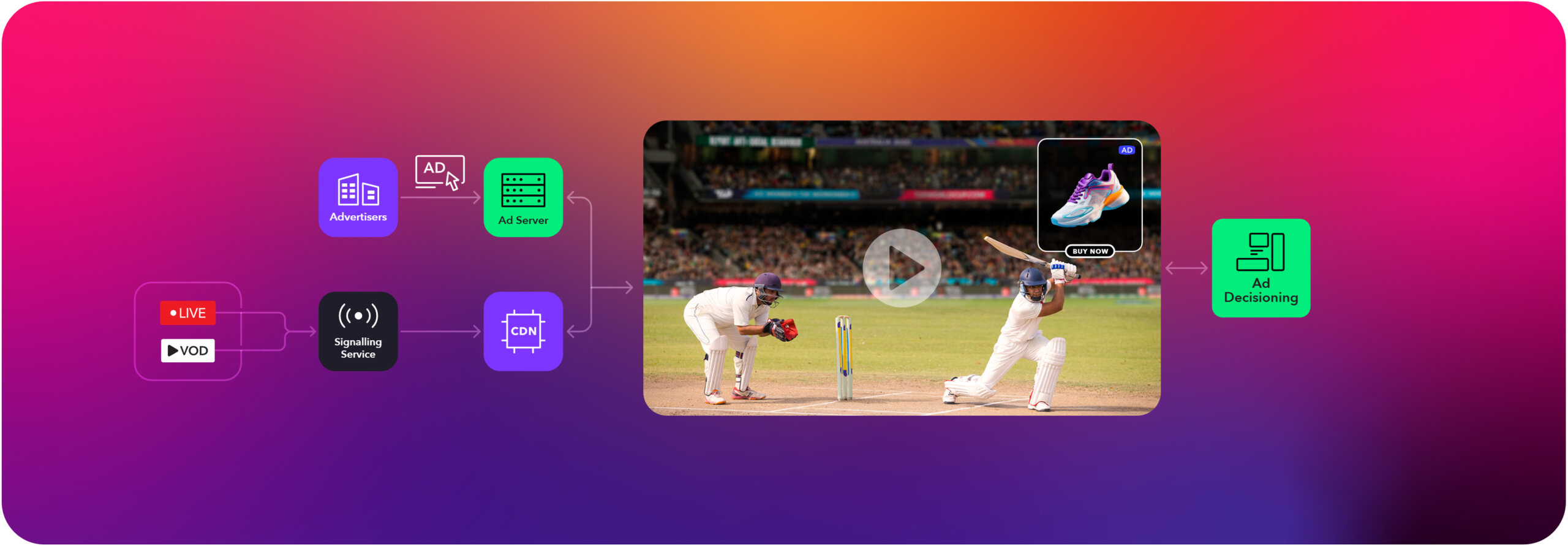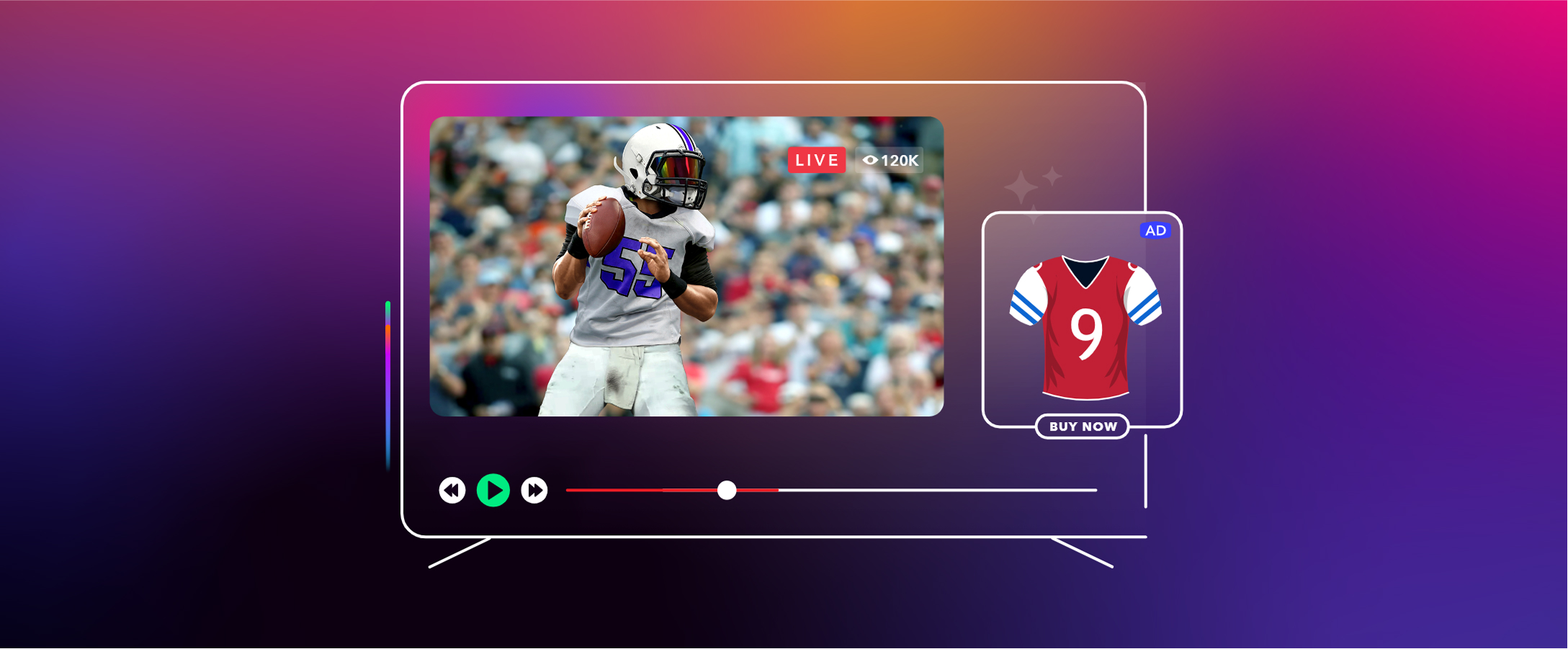Advertising is an essential source of revenue for many broadcasters and media publishers. This monetization method has come a long way since it emerged in traditional broadcasting methods, like satellite and cable.
In the past, all viewers were served the same ads since commercials targeted the network’s general audience, not individual viewers. However, streaming ad technology has evolved to create more personalized experiences, leading to greater engagement and better results.
In this article, we will discuss all things related to streaming TV advertising. We’ll talk about what streaming advertising is and how it works. We’ll compare different ad-insertion techniques and provide some points to consider when determining if streaming advertising is the right monetization method for you.
What is streaming TV advertising?
Streaming TV advertising, also known as connected TV (CTV) advertising, is a monetization method that allows viewers to “pay” for their content by watching ads paid for by brands. This technique is used to monetize content that is streamed over the internet.
This is very similar to how commercials work on traditional television. However, streaming TV advertising has the advantage of using ad targeting technology. This improves the user experience (and the performance of the ads) by tailoring the content to unique viewers.
Streaming ads can be placed pre-roll, mid-roll, and post-roll. Some broadcasters prefer to keep the ads before or after the stream so the viewer experience is not compromised.
How does streaming advertising work?
Streaming advertising is made possible with the help of an ad server. The ad server is the intermediary between the advertisers and the video player, creating a seamless experience that viewers would expect while watching TV. Streaming ads are delivered over the internet just like other streaming media.
As we mentioned, streaming ads can be targeted to specific viewers. This is made possible by leveraging a few different information sources. These include:
- First-party data: Customer data collected from advertisers; includes customer names, email addresses, purchase histories, online behavior, and more
- Third-party data: Data purchased from outside sources; includes demographic and behavioral information
- IP targeting: Categorizing ad targets based on location; targeting entire households rather than individual viewers
These are the same data sources used for targeted ads on smartphones, tablets, and computers.
Streams advertising technology also collects data on ad performance and how viewers interact with the ads. These insights are extremely valuable to advertisers since they help them determine how to structure campaigns moving forward. The ad servers also use this data loop to optimize the selection of ads served to each viewer.

Ad-insertion methods for streaming TV: SGAI vs. SSAI vs. CSAI
You can use several different ad insertion methods to serve advertisements on your streaming TV apps. These include Server-Guided Ad Insertion (SGAI), Server-Side Ad Insertion (SSAI), and Client-Side Ad Insertion (CSAI).
In the past, SSAI and CSAI were the only two options available. SSAI brought the benefits of a smooth user experience and resilience against ad blockers, whereas CSAI put more control in the broadcaster’s hands, allowing for more personalized viewer experiences. The ultimate tradeoff broadcasters face when choosing between SSAI and CSAI is between scalability and cross-platform support, with SSAI thriving in cross-platform support and CSAI thriving in scalability.
However, SGAI flips the script, merging the strengths of SSAI and CSAI. This improves the viewer experience and yields better results for broadcasters.
Since the player leads SGAI, it is particularly valuable for serving ads in low-latency streaming. It enables the stream to be pulled to a smaller window within the player while the advertisement is displayed alongside the stream. That way, the steam is not interrupted while the ad plays.
Since media publishers can control the timing of the ad breaks in real-time with SGAI, relevant products or brands can be promoted during significant points within the stream. For example, if Nike sponsors a player on a hockey team, a Nike ad could be triggered when that player scores a goal.
If you’re looking for a powerful ad-insertion solution that supports SGAI, Dolby OptiView has the solution for you. Contact us to learn more about how our solution can help you improve viewer engagement and grow ad revenue
Pros and cons of streaming TV advertising
Like any streaming TV monetization method, ad-supported content has several pros and cons. Let’s talk about some things to consider as you weigh your options.
Benefits of streaming TV advertising
- Lowers the barrier to entry for viewers
- Provides viewers access to content for free or at a reduced price
- Ads are targeted to viewers based on observed preferences and behavior
- Can be combined with other streaming TV monetization methods
- Valuable to advertisers because it reaches audiences where they are at (i.e., streaming content online vs. watching cable)
- More cost-effective for advertisers
- Can be made interactive
Challenges of streaming TV advertising
- Some operating systems have ad blockers
- Many viewers skip ads due to ad fatigue
- Some users don’t want to watch ad-supported content
- Some privacy concerns since ads use personal data
Who uses streaming TV advertising?
Hulu and YouTube are two of the most notable streaming services that use advertising to monetize streaming TV.
Streaming advertising is particularly popular in on-demand content since it’s easy to stitch ads into this content style without throwing off the user experience. However, thanks to the rise of Server-Guided Ad Insertion, advertising is becoming a viable monetization method for live streaming, as well.
As advertising within live streams grows in popularity, it becomes a viable option for sports, horse racing, eSports, iGaming, and other industries. It remains a popular monetization method for entertainment and news content.

Final thoughts
Advertising is a great way to monetize your streaming TV content, especially if you want to make it available to users for cheap or free.
Looking to monetize your streaming TV apps with advertisements? Dolby OptiView’s Server-Guided Ad Insertion technology is here to help you seamlessly incorporate ads on your streaming TV experiences and beyond. Contact us to learn more about our advertising solution.
FAQs
Several other monetization methods can be used alongside or in place of advertising. Some of the top options include subscriptions, pay-per-view, and rentals. These methods are often paired with monetization methods, like in-stream shopping or sponsorships.
You can mix and match these monetization techniques to create a strategy that makes sense for your audience and the type of content you offer.
Some key metrics for measuring the success of streaming TV ads include cost per mille (CPM), impressions, ad viewability rate, completion rate, and conversion rate.








